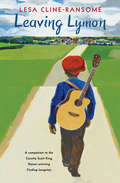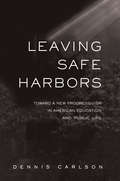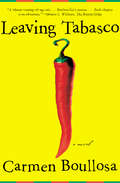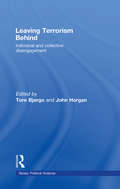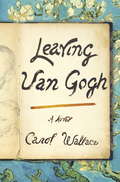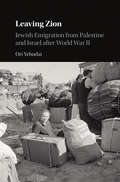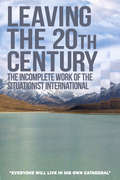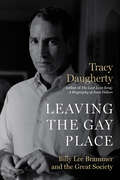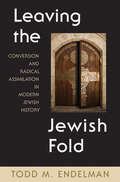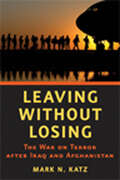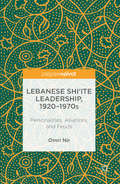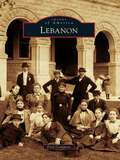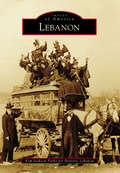- Table View
- List View
Leaving Lucy Pear
by Anna Solomon"Anna Solomon writes with a poet's reverence for language and a novelist's ability to keep us turning the page. A gorgeous and engrossing meditation on motherhood, womanhood, and the sacrifices we make for love."--J. Courtney Sullivan, author of Maine and The EngagementsChosen as a must-read book for summer 2016 by TIME Magazine, InStyle, Us Weekly, Good Housekeeping, and The MillionsSet in 1920s New England, the story of two women who are both mothers to the same unforgettable girl--a big, heartrending novel from award-winning writer Anna SolomonOne night in 1917 Beatrice Haven sneaks out of her uncle's house on Cape Ann, Massachusetts, leaves her newborn baby at the foot of a pear tree, and watches as another woman claims the infant as her own. The unwed daughter of wealthy Jewish industrialists and a gifted pianist bound for Radcliffe, Bea plans to leave her shameful secret behind and make a fresh start. Ten years later, Prohibition is in full swing, post-WWI America is in the grips of rampant xenophobia, and Bea's hopes for her future remain unfulfilled. She returns to her uncle's house, seeking a refuge from her unhappiness. But she discovers far more when the rum-running manager of the local quarry inadvertently reunites her with Emma Murphy, the headstrong Irish Catholic woman who has been raising Bea's abandoned child--now a bright, bold, cross-dressing girl named Lucy Pear, with secrets of her own.In mesmerizing prose, award-winning author Anna Solomon weaves together an unforgettable group of characters as their lives collide on the New England coast. Set against one of America's most turbulent decades, Leaving Lucy Pear delves into questions of class, freedom, and the meaning of family, establishing Anna Solomon as one of our most captivating storytellers.From the Hardcover edition.
Leaving Lucy Pear
by Anna Solomon'Stunning language, raw emotion and profound wisdom' Celeste Ng, author of Everything I Never Told You'Solomon's strong prose and fleet pacing consistently provide the essential pleasures of a good story well told' Maggie Shipstead, The New York Times Book ReviewOne night in 1917 Beatrice Haven creeps out of her uncle's house on Cape Ann, Massachusetts, leaves her newborn baby at the foot of a pear tree, and watches as another woman claims the child as her own. A gifted pianist bound for Radcliffe, Bea plans to leave her shameful secret behind and make a fresh start. Ten years later, Prohibition is in full swing, post-WWI America is in the grips of rampant xenophobia, and Bea has returned to her uncle's house, seeking a refuge from her unhappiness. But the rum-running manager of the local quarry inadvertently reunites her with Emma Murphy, the headstrong Irish Catholic woman who has been raising her abandoned child - now a bright, bold, cross-dressing girl named Lucy Pear, with secrets of her own...
Leaving Lymon
by Lesa Cline-RansomeBehind every bad boy is a story worth hearing and at least one chance for redemption. It's 1946 and Lymon, uprooted from his life in the Deep South and moved up North, needs that chance. <P><P>Lymon's father is, for the time being, at Parchman Farm--the Mississippi State Penitentiary--and his mother, whom he doesn't remember all that much, has moved North. Fortunately, Lymon is being raised by his loving grandparents. Together, Lymon and his grandpops share a love of music, spending late summer nights playing the guitar. But Lymon's world as he knows it is about to dissolve. He will be sent on a journey to two Northern cities far from the country life he loves--and the version of himself he knows. In this companion novel to the Coretta Scott King Honor wining Finding Langston, readers will see a new side of the bully Lymon in this story of an angry boy whose raw talent, resilience, and devotion to music help point him in a new direction. <P><P>A Junior Library Guild Selection!
Leaving Orbit: Notes from the Last Days of American Spaceflight
by Margaret Lazarus DeanWinner of the Graywolf Press Nonfiction Prize, a breathtaking elegy to the waning days of human spaceflight as we have known itIn the 1960s, humans took their first steps away from Earth, and for a time our possibilities in space seemed endless. But in a time of austerity and in the wake of high-profile disasters like Challenger, that dream has ended. In early 2011, Margaret Lazarus Dean traveled to Cape Canaveral for NASA's last three space shuttle launches in order to bear witness to the end of an era. With Dean as our guide to Florida's Space Coast and to the history of NASA, Leaving Orbit takes the measure of what American spaceflight has achieved while reckoning with its earlier witnesses, such as Norman Mailer, Tom Wolfe, and Oriana Fallaci. Along the way, Dean meets NASA workers, astronauts, and space fans, gathering possible answers to the question: What does it mean that a spacefaring nation won't be going to space anymore?
Leaving Rock Harbor
by Rebecca ChaceAn unforgettable coming-of-age story and a luminous portrayal of a dramatic era of American history, Rebecca Chace’sLeaving Rock Harbortakes readers into the heart of a New England mill town in the early twentieth century. On the eve of World War I, fourteen-year-old Frankie Ross and her parents leave their simple life in Poughkeepsie to seek a new beginning in the booming city of Rock Harbor, Massachusetts. Frankie’s father finds work in a bustling cotton mill, but erupting labor strikes threaten to dismantle the town’s socioeconomic structure. Frankie soon befriends two charismatic young men—Winslow Curtis, privileged son of the town’s most powerful politician, and Joe Barros, a Portuguese mill worker who becomes a union organizer—forming a tender yet bittersweet love triangle that will have an impact on all three throughout their lives. Inspired in part by Chace’s family history, Frankie’s journey to adulthood takes us through the First World War and into the Jazz Age, followed by the Great Depression—from rags to riches and back again. Her life parallels the evolution of the mill town itself, and the lost promise of a boomtown that everyone thought would last forever. Of her acclaimed novelCapture the Flag, theLos Angeles Timessaid, "Chace’s writing resembles a generation of New York writers heavily influenced by John Updike: Rick Moody, A. M. Homes, Susan Minot, and, more recently, Melissa Bank. " With its lyrical prose and compelling style,Leaving Rock Harborfurther establishes Chace’s position in that literary tradition.
Leaving Safe Harbors: Toward a New Progressivism in American Education and Public Life
by Dennis CarlsonTo rise to the challenges of postmodern culture, Carlson argues, progressives will need to leave the safe harbors of what is familiar and comfortable. A new progressivism can only be forged of a fundamental re-thinking and re-mythologizing of democratic education. Drawing upon cultural studies perspectives, Carlson interrogates philosophy through p
Leaving Shades: A captivating Cornish saga filled with love and secrets (Leaving Shades Sagas)
by Gloria CookWhen Beth returns to her childhood home, she discovers that much of her life has been based on deception...After a tragic miscarriage, Beth Tresaile returns to Owles House, the place of her miserable childhood, accompanied by her best friend, Kitty Copeland. Beth is determined to get revenge on her estranged mother, Christina, who neglected and abandoned her. But Beth slowly begins to discover that much of her childhood was built on deception.Kitty is captivated with Cornwall, and Beth reluctantly becomes involved with the locals. However, there are fresh troubles ahead when her married lover, Kitty’s brother, wants to come back into her life…A captivating Cornish saga filled with love and secrets, perfect for fans of Anna Jacobs and Margaret Dickinson.
Leaving Tabasco: A Novel (Books That Changed the World)
by Carmen BoullosaA young woman encounters strange events in her Mexican hometown in this novel by an author who “immerses us…in her wickedly funny and imaginative world” (Latina).Leaving Tabasco tells of the coming of age of Delmira Ulloa, raised in an all-female home in Agustini, in the Mexican province of Tabasco. In Agustini it is not unusual to see your grandmother float above the bed when she sleeps, or to purchase torrential rains at a traveling fair, or to watch your family’s elderly serving woman develop stigmata, then disappear completely, to be canonized as a local saint. But as Delmira becomes a woman, she will set out on a search for her missing father, and must make a choice that could mean leaving her home forever, in a tale filled with both depth and delightful mystery that poses questions about just how real the real world is. “To flee Agustini is to leave not just a town but the viscerally primal dreamscape it represents.”— The New York Times Book Review“Vibrant…Each chapter is an adventure.”—The Boston Globe“We happily share with [Delmira] her life, including the infinitely charming town she inhabits [and] her grandmother’s fantastic imagination.”—The Washington Post Book World
Leaving Terrorism Behind: Individual and Collective Disengagement (Political Violence)
by John Horgan Tore BjorgoThis new edited volume expands our understanding of the processes by which individuals and groups disengage from terrorism. While there has been a growing awareness of the need to understand and prevent processes of radicalization into terrorism, disengagement and deradicalization from terrorism have long been neglected areas in research on terrorism. This book uses empirical data to explore how and why individuals and groups disengage from terrorism, and what can be done to facilitate it. The work also presents a series of case studies of disengagement programmes, from Colombia, northern Europe, Italy, Yemen, Saudi Arabia, Indonesia, Singapore and Malaysia, comparing and assessing their various strengths and weaknesses. In light of the lessons learned from these cases, this book describes and explains the potential for new developments in counter-terrorism. This book will be of great interest to all students of terrorism studies, war and conflict studies, international security and politics in general, as well as professionals in the field of counter-terrorism.
Leaving The Twentieth Century: Situationist Revolutions
by McKenzie WarkThe acclaimed history of the groundbreaking Situationist movementThe Situationist International, which leaped to the fore during the Paris tumult of 1968, has extended its revolutionary influence right up to the present day. In Leaving the Twentieth Century, the movement is captured for the first time in its full range and diversity.McKenzie Wark traces the group&’s development from the bohemian Paris of the &’50s to the explosive days of May &’68. She introduces the group as an ensemble, revealing the work and activities of thinkers previously obscured by the reputation of founding member Guy Debord. Roaming through Europe and exploring the vital lives its members—including Constant, Asger Jorn, Michèle Bernstein, Alexander Trocchi, and Jacqueline de Jong—Wark uncovers a group riven with conflicting passions. She follows the narrative beyond 1968, to the Situationists International&’s disintegration and beyond: the ideas of T. J. Clark, the Fourierist utopia of Raoul Vaneigem, René Vienet&’s earthy situationist cinema, Gianfranco Sanguinetti&’s pranking of the Italian ruling class, Alice Becker-Ho&’s account of the anonymous language of the Romany, and Debord&’s late films and his surprising work as a game designer.
Leaving Van Gogh
by Carol WallaceIn the summer of 1890, in the French town of Auvers-sur-Oise, Vincent van Gogh shot himself in the chest with a revolver. He died two days later, at the age of thirty-seven, largely unknown despite having completed over two thousand works of art that would go on to become some of the most important and valued in the world. In this riveting novel, Carol Wallace brilliantly navigates the mysteries surrounding the master artist's death, relying on meticulous research to paint an indelible portrait of Van Gogh's final days--and the friendship that may or may not have destroyed him. Telling Van Gogh's story from an utterly new perspective--that of his personal physician, Dr. Gachet, specialist in mental illness and great lover of the arts--Wallace allows us to view the legendary painter as we've never seen him before. In our narrator's eyes, Van Gogh is an irresistible puzzle, a man whose mind, plagued by demons, poses the most potentially rewarding challenge of Gachet's career. Wallace's narrative brims with suspense and rich psychological insight as it tackles haunting questions about Van Gogh's fate. A masterly, gripping novel that explores the price of creativity, Leaving Van Gogh is a luminous story about what it means to live authentically, and the power and limits of friendship.From the Hardcover edition.
Leaving World War II Behind
by David SwansonThis book documents the case that World War II happened in such a different world that it has little relevance to today's foreign policy, as well as the case that U.S. participation in WWII was not justifiable. Specifically, WWII was not fought to rescue anyone from persecution, was not necessary for defense, was the most damaging and destructive event yet to occur, and would not have happened had any one of these factors been missing: World War I, the manner in which WWI was ended, U.S. funding and arming of Nazis, a U.S. arms race with Japan, U.S. development of racial segregation, U.S. development of eugenics, U.S. development of genocide and ethnic cleansing, or the U.S. and British prioritization of opposing the Soviet Union at all costs. The author corrects numerous misconceptions about the most popular and misunderstood war in western culture, in order to build a case for moving to a world beyond war.
Leaving Zion: Jewish Emigration from Palestine and Israel after World War II
by Ori YehudaiThe story of Israel's foundation has often been told from the perspective of Jewish immigration to the Land of Israel. Leaving Zion turns this historical narrative on its head, focusing on Jewish out-migration from Palestine and Israel between 1945 and the late 1950s. Based on previously unexamined primary sources collected from twenty-two archives in six countries, Ori Yehudai demonstrates that despite the dominant view that displaced Jews should settle in the Jewish homeland, many Jews instead saw the country as a site of displacement or a way-station to more desirable lands. Weaving together the perspectives of governments, aid organizations, Jewish communities and the personal stories of individual migrants, Yehudai brings to light the ideological, political and social tensions surrounding emigration. Covering events in the Middle East, Europe and the Americas, this study provides a fresh transnational perspective on the critical period surrounding the birth of Israel and the post-Holocaust reconstruction of the Jewish world.
Leaving the 20th Century: The Incomplete Work of the Situationist International
by Christopher GrayThe first Situationist text to be published in the UK in 1974, 'Leaving the 20th Century' was Chris Gray and the English situationists' attempt to capture and distil the vibrant anti-art, anti-capitalist energy of the original International Situationist texts (1957-74). With its loose translations and irreverent commentary, Gray and co. attempted to capture the "terrorism, wit and general megalomania" of the original publications, whilst faithfully reprinting the "photographs of girls, soldiers, bombings, comic-strip frames, maps of cities and diagrams of labyrinths, cathedrals and gardens." From the art/anti-art beginnings, to the role of the Situationists in the worker-student insurrection of May 68', 'Leaving the 20th Century' remains the definitive English pro-situ text.
Leaving the Fight: Surrender, Prisoners of War, and Detainees in Western Warfare (Cambridge Military Histories)
by John A. Lynn IISurrender in warfare has determined the fate of governments, states, and nations. It has reduced powerful commanders to powerless captives and inflicted submission, degradation, and even death on common soldiers held as prisoners of war. It has also led to civilian detainees being grossly mistreated and murdered. However, surrender, prisoners of war, and detainees have rarely been addressed as general phenomena in warfare. Leaving the Fight is then an essential history of the evolution of surrender from the Middle Ages to the present day. John A. Lynn II explores the different forms taken by surrender, from the abject capitulation of armies and states to the withdrawal of forces from military interventions deemed to be unwinnable, such as in Vietnam and Afghanistan. He also considers the fates of prisoners of war and civilians detained by military forces from harsh treatment intended to intimidate foes to attempts to win over hearts and minds.
Leaving the Gay Place: Billy Lee Brammer and the Great Society
by Tracy Daugherty&“By turns a strong, clear biography (with shades of rock n roll memoir), a poetic ode to various places and people in midcentury Texas and an oral history.&” —Texas Observer Acclaimed by critics as a second F. Scott Fitzgerald, Billy Lee Brammer was once one of the most engaging young novelists in America. When he published his first and only novel, The Gay Place, in 1961, literary luminaries such as David Halberstam, Willie Morris, and Gore Vidal hailed his debut. Halberstam called it &“a classic . . . [A] stunning, original, intensely human novel inspired by Lyndon Johnson . . . It will be read a hundred years from now.&” More recently, James Fallows, Gary Fisketjon, and Christopher Lehmann have affirmed The Gay Place&’s continuing relevance, with Lehmann asserting that it is &“the one truly great modern American political novel.&” Leaving the Gay Place tells a sweeping story of American popular culture and politics through the life and work of a writer who tragically exemplifies the highs and lows of the country at mid-century. Tracy Daugherty follows Brammer from the halls of power in Washington, DC, where he worked for Senate majority leader Johnson, to rock-and-roll venues where he tripped out with Janis Joplin, and ultimately to back alleys of self-indulgence and self-destruction. Constantly driven to experiment with new ways of being and creating—often fueled by psychedelics—Brammer became a cult figure for an America on the cusp of monumental change, as the counterculture percolated through the Eisenhower years and burst out in the sixties. In Daugherty&’s masterful recounting, Brammer&’s story is a quintessential American story, and Billy Lee is our wayward American son.
Leaving the Jewish Fold
by Todd EndelmanBetween the French Revolution and World War II, hundreds of thousands of Jews left the Jewish fold--by becoming Christians or, in liberal states, by intermarrying. Telling the stories of both famous and obscure individuals, Leaving the Jewish Fold explores the nature of this drift and defection from Judaism in Europe and America from the eighteenth century to today. Arguing that religious conviction was rarely a motive for Jews who became Christians, Todd Endelman shows that those who severed their Jewish ties were driven above all by pragmatic concerns--especially the desire to escape the stigma of Jewishness and its social, occupational, and emotional burdens. Through a detailed and colorful narrative, Endelman considers the social settings, national contexts, and historical circumstances that encouraged Jews to abandon Judaism, and factors that worked to the opposite effect. Demonstrating that anti-Jewish prejudice weighed more heavily on the Jews of Germany and Austria than those living in France and other liberal states as early as the first half of the nineteenth century, he reexamines how Germany's political and social development deviated from other European states. Endelman also reveals that liberal societies such as Great Britain and the United States, which tolerated Jewish integration, promoted radical assimilation and the dissolution of Jewish ties as often as hostile, illiberal societies such as Germany and Poland. Bringing together extensive research across several languages, Leaving the Jewish Fold will be the essential work on conversion and assimilation in modern Jewish history for years to come.
Leaving the South: Border Crossing Narratives and the Remaking of Southern Identity
by Mary Weaks-BaxterMillions of Southerners left the South in the twentieth century in a mass migration that has, in many ways, rewoven the fabric of American society on cultural, political, and economic levels. Because the movements of Southerners—and people in general—are controlled not only by physical boundaries marked on a map but also by narratives that define movement, narrative is central in building and sustaining borders and in breaking them down. In Leaving the South: Border Crossing Narratives and the Remaking of Southern Identity, author Mary Weaks-Baxter analyzes narratives by and about those who left the South and how those narratives have remade what it means to be southern. Drawing from a broad range of narratives, including literature, newspaper articles, art, and music, Weaks-Baxter outlines how these displacement narratives challenged concepts of Southern nationhood and redefined Southern identity. Close attention is paid to how depictions of the South, particularly in the media and popular culture, prompted Southerners to leave the region and changed perceptions of Southerners to outsiders as well as how Southerners saw themselves. Through an examination of narrative, Weaks-Baxter reveals the profound effect gender, race, and class have on the nature of the migrant’s journey, the adjustment of the migrant, and the ultimate decision of the migrant either to stay put or return home, and she connects the history of border crossings to the issues being considered in today’s national landscape.
Leaving without Losing: The War on Terror after Iraq and Afghanistan
by Mark N. KatzAs the United States withdraws its combat troops from Iraq and Afghanistan, politicians, foreign policy specialists, and the public are worrying about the consequences of leaving these two countries. Neither nation can be considered stable, and progress toward democracy in them—a principal aim of America and the West—is fragile at best. But, international relations scholar Mark N. Katz asks: Could ending both wars actually help the United States and its allies to overcome radical Islam in the long term?Drawing lessons from the Cold War, Katz makes the case that rather than signaling the decline of American power and influence, removing military forces from Afghanistan and Iraq puts the U.S. in a better position to counter the forces of radical Islam and ultimately win the war on terror. He explains that since both wars will likely remain intractable, for Washington to remain heavily involved in either is counter-productive. Katz argues that looking to its Cold War experience would help the U.S. find better strategies for employing America’s scarce resources to deal with its adversaries now. This means that, although leaving Afghanistan and Iraq may well appear to be a victory for America’s opponents in the short term—as was the case when the U.S. withdrew from Indochina—the larger battle with militant Islam can be won only by refocusing foreign and military policy away from these two quagmires.This sober, objective assessment of what went wrong in the U.S.–led wars in Afghanistan and Iraq and the ways the West can disentangle itself and still move forward draws striking parallels with the Cold War. Anyone concerned with the future of the War on Terror will find Katz’s argument highly thought provoking.
Lebanese Blonde: A Novel
by Joseph Geha<P>Lebanese Blonde takes place in 1975-76 at the beginning of Lebanon's sectarian civil war. <P>Set primarily in the Toledo, Ohio, "Little Syria" community, it is the story of two immigrant cousins: Aboodeh, a self-styled entrepreneur; and Samir, his young, reluctant accomplice. <P>Together the two concoct a scheme to import Lebanese Blonde, a potent strain of hashish, into the United States, using the family's mortuary business as a cover. <P>When Teyib, a newly arrived war refugee, stumbles onto their plans, his clumsy efforts to gain acceptance raise suspicion. Who is this mysterious "cousin," and what dangers does his presence pose? <P>Aboodeh and Samir's problems grow still more serious when a shipment goes awry and their links to the war-ravaged homeland are severed. <P>Soon it's not just Aboodeh and Samir's livelihoods and futures that are imperiled, but the stability of the entire family.
Lebanese Historical Thought in the Eighteenth Century (Routledge Approaches to History #53)
by Hayat El BualuanThis study of Lebanese historical thought and its role in national identity formation in the eighteenth century focuses on a sample of historians, mainly Christians, who lived and wrote during the Shihabi Emirate from 1697 till the Egyptian invasion in 1831. These historians, who represent different trends in historical writing, were able to develop the idea of Lebanon as a unique entity and as a haven and to underline its specificity and distinctiveness. With a focus on primary sources, this book endeavors to penetrate into the main concerns and ways of thinking at this time when a Lebanese identity started to bloom. In doing so, it discovers a neglected century as a fruitful and rich period in the history of Lebanon and a prelude to nineteenth-century awakening. This book will be of interest to scholars of the history and historiography of Lebanon and the Middle East, with relevance for specialized courses in the fields of history and historiography at universities.
Lebanese Shi‘ite Leadership, 1920–1970s
by Omri NirThis book examines the coalitions and relationships within the power centers of Shi'ite politics during the era of political feudalism in Lebanon. The author maps the Shi'ite leadership and its inter-connections, including the alliances and rivalry between prominent Zu'ama, clans, and Ulama' from the formation of Lebanon in 1920 to the decline of old Shi'ite politics and the emergence of popular movements in the 1970s. The work also explains the role of prominent intellectuals within these power centers.
Lebanon
by Fred ComptonFounded in 1802, Lebanon, Ohio, was once dubbed by noted author and broadcaster Charles Kurault as the most historic spot in the state. Home to Ohio's oldest business, the iconic Golden Lamb, and the oldest weekly newspaper west of the Allegheny Mountains, the Western Star, Lebanon has sat quietly by the side of the road for over two centuries and waited while the world came to it. Located midway on the main stage route between Cincinnati and Dayton, Lebanon was a natural stopping point for travelers throughout the 19th and early 20th centuries, including 12 U.S. presidents and numerous authors and dignitaries who would help mold America's future. Along the way, Lebanon was home to one of the earliest coeducational teachers colleges, National Normal University, and the largest Shaker community in the west, Union Village. The men and the monuments are all gone now, but the city, rich in history and heritage, remains.
Lebanon
by Historic Lebanon Kim Jackson ParksFounded in 1802 and named for the biblical land of cedars, Lebanon has been a center for commerce, education, and culture for over 200 years. The rich histories of Cumberland University, Cumberland School of Law, and Castle Heights Military Academy are intertwined with the city. Cumberland University served as Director Headquarters for the Tennessee Maneuvers of the Second Army during World War II. Politicians such as Sam Houston, William Jennings Bryan, and Frank Clement all used the Lebanon Square as a public forum. In fact, Sam Houston began his law career here in 1818. Known as the wool capital of Tennessee for many years, Lebanon was home to the Lebanon Woolen Mills for nearly a century. This strong business tradition continues today. Cracker Barrel Old Country Store, founded here in 1969, maintains its national headquarters in the city.
Lebanon
by Jan McdanielIn the 1980s Lebanon-and particularly its capital, Beirut-was considered one of the most dangerous places in the world, particularly for Americans. Today, as the country continues to rebuild after its devastating 15-year civil war, tourists are beginning to return to Lebanon's Mediterranean resorts. Yet Lebanon has many problems. Years of political domination by Syria made progress difficult, and various political factions have struggled for control of Lebanon's government. In addition, more than 380,000 Palestinians live in Lebanon, and terrorist organizations such as Hezbollah and Hamas operate freely inside the country. As a result, Lebanon's future remains uncertain. Discusses the geography, history, economy, government, religion, people, foreign relations, and major cities of Lebanon.


